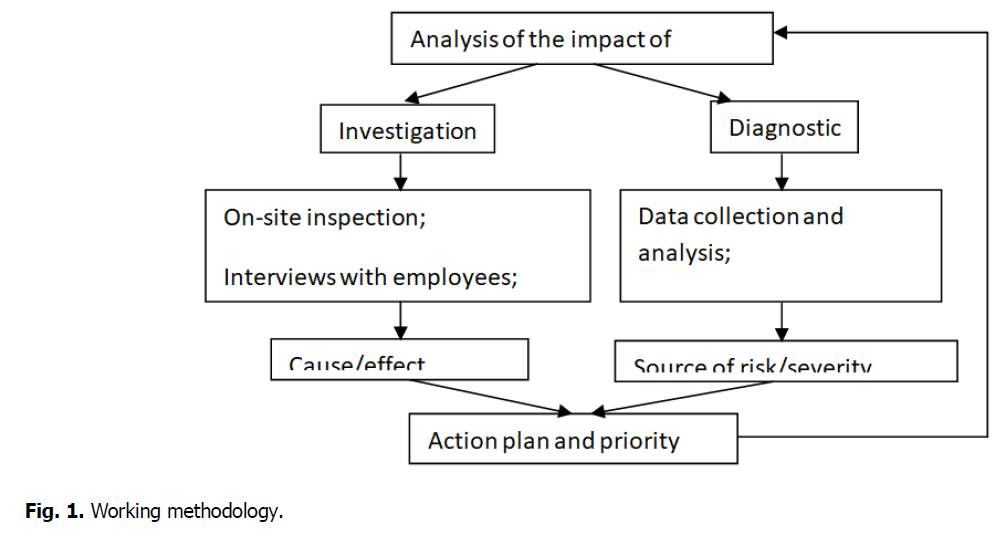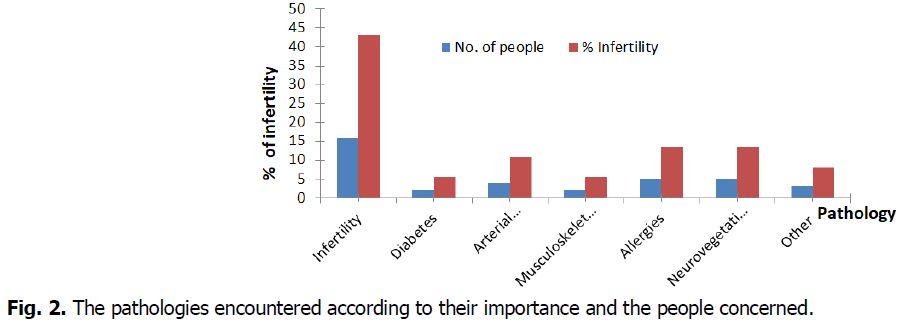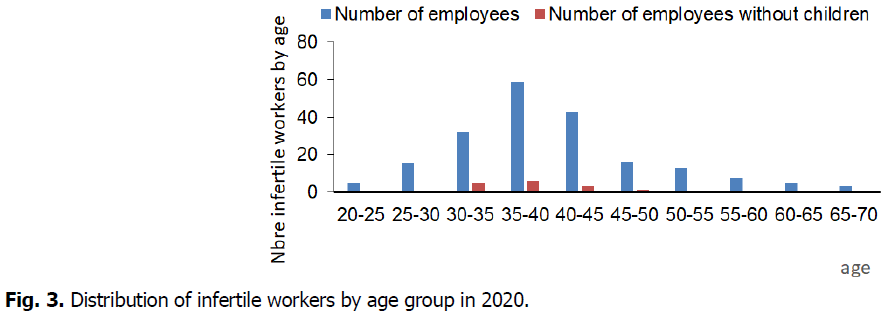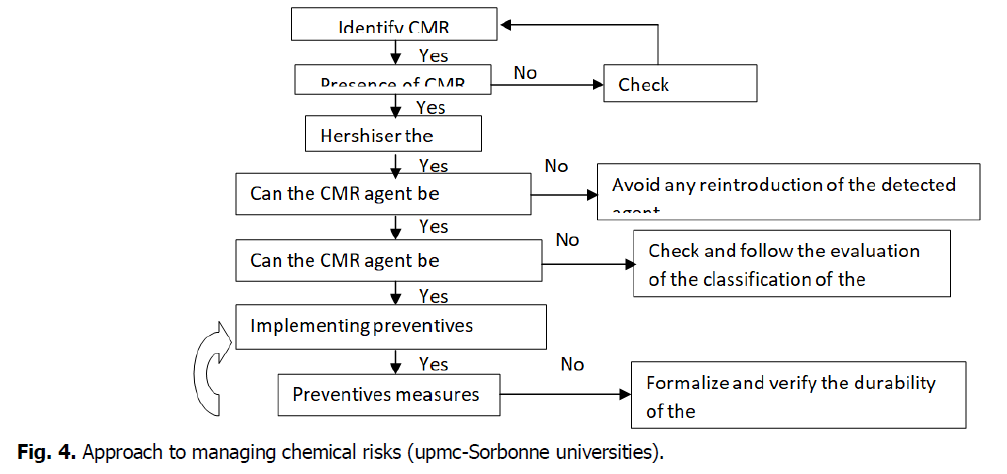Research Article - (2022) Volume 12, Issue 1
Contribution to the analysis of the impact of hazardous chemicals on employee health case study: Company SARL EL CHAFEK (Algeria)
R. Bouzerara1*, R. Chaib1 and I. Verzea2Abstract
Iindustrial hygiene can be reduced as the anticipation, identification, evaluation and control of health risks in the work area, or even putting primary prevention at the heart of our occupational health system. Henceforth, the prevention and occupational health services no longer have as their exclusive mission to avoid any alteration of the health of workers due to their work, even if this remains their main mission. However, its ultimate goal is to preserve the health and well-being of workers, during their working life, with a state of health compatible with their continued employment, or even their retirement in good health. Thus, this prevention also contributes to the achievement of public health objectives. Two main techniques are used in this work: investigation and diagnosis. Investigation means searching for the causes of observed or anticipated effects, inspecting workplaces, conducting preventive interviews with employees and investigating incidents and accidents. As for the diagnostic side, it consists in defining the sources of risk, the seriousness of the risk and the necessary means to reduce it to an acceptable level or to eliminate it completely, which is the objective of this work, by means of observations and data collected in the workplace. As a case study, we have chosen a battery manufacturing and recovery company.
Keywords
Prevention, Chemical product, CMR, Health, Well being, Investigation, Diagnosis and retreat.
Introduction
Chemicals are essential to the production of a large number of industrial goods. Thanks to these products, millions of people work, produce and consumer goods necessary to life. Unfortunately, there is growing concern about their effects on health and the environment (Chaib et al., 2020; 2019; Drakvik et al., 2020; Godfray et al., 2019). If used improperly, without basic or special precautions, many of these chemicals can become dangerous and sometimes cause major accidents and serious illnesses. Some of these substances can have significant harmful effects on the environment and health, even in small doses. Other substances are also of concern because of their persistence in the environment, the difficulty of measuring them and the lack of knowledge of their long-term environmental and health impact (Gavrilescu et al., 2015; Chaib, 2016; Wang et al., 2015; Noguera-Oviedo et al., 2016). Therefore, the management and evaluation of their risks is essential and becomes a priority for any company using chemicals. Consequently, a quarter of all deaths in the world are attributable to an unhealthy environment, in particular the presence of chemicals that are poorly controlled, used or handled (W.H.O., 2017). As a result, every year, many workers suffer accidents, some of them serious or even fatal, or contract occupational diseases because they are exposed to multiple risks induced by the machines they operate and the work environment in which they evolve.. Its ultimate goal is to preserve the health and well-being of workers throughout their working lives, with a state of health compatible with maintaining employment or even retiring in good health. Prevention therefore also contributes to the achievement of public health objectives (Strand et al., 2016; Naranjo-Gil et al., 2016; Nazar et al., 2020). Thus, the continuous, permanent and sustainable improvement of the safety and health of employees, the protection of society and the environment is essential and becomes everyone's business. As a result, achieving a principle of sustainable development in occupational health and safety in companies is a major principle for employees, retirees, the company and the environment, and even public health.
Methods
Any company must know, identify, evaluate, and even map these risks in order to control them, while instilling the use of processes, methods and risk management tools, and even dynamic and controlled adaptation to changing circumstances, while respecting the principles of sustainable development in terms of occupational health and safety. In this research work, two main techniques are applied: investigation and diagnosis (Kullak-Ublick et al., 2017; Flores Kim et al., 2018). Investigation is the search for the causes of observed or anticipated effects, either through inspection of the workplace, preventive interview with employees and thus investigates incidents and accidents that have occurred company. As for the diagnostic side, it consists of using observations and data collected in the workplace to define the sources of risk, the severity of the risk and the means necessary to reduce it to an acceptable level or eliminate it completely, the objective of this work. As a case study, we have taken the company SARL EL CHAFEK (Fig. 1).

Fig 1. Working methodology.
Presentation of the company
The company SARL EL CHAFEK is established in the Dayara of Ain M' Lila in Algeria since 2006. Its mission is to manufacture starter batteries with sulfuric acid, demineralized water and recycled lead with a varied range of batteries of different capacities, with about 250,000 batteries/year for all types of standard and Asian light and heavy vehicles. As a reminder, a lead-acid battery is a set of lead-sulfuric acid accumulators connected in series, in order to obtain the desired voltage, and gathered in the same case. The lead plates and grids are actually made of hardened lead (e.g., with tin, cadmium and strontium in a few percent of the alloy).
Nowadays, lead, if ingested or breathed in, can be the cause of acute or chronic poisoning (Hayatbakhsh, et al., 2017; Kianoush, et al., 2015; Rezaei, et al., 2019). It can be the cause of lead poisoning (Rezaei, et al., 2019; Mirza, et al., 2017). A good control of the risks presented by used lead-acid batteries is therefore essential, and because it is a hazardous waste for health and for the environment. Consequently, these batteries must be collected and reprocessed by specialized companies. In order to prevent pollution risks, companies are generally required to implement processes that comply with the best available techniques and are subject to strict and regular controls. They must also guarantee a high level of protection for their employees. This protection includes training in lead-related risks and the systematic use of collective and individual protective equipment. The effectiveness of these measures is regularly verified by measuring the blood lead levels of employees.
Thus, the mission of SARL EL CHAFEK's company is in line with a strong and responsible environmental approach while engaging with the public authorities and a specialized control organization to constantly improve the quality of these installations and industrial processes.
Some reminders of the harmful effects of chemicals
What is an adverse health effect? A generic definition of an adverse health effect is: "Any change in body functions or cell structures that can lead to disease or health problems": Adverse health effects include (Sifakis, et al., 2017; Kim, et al., 2018; Eckelman, et al., 2016; Yeboue, et al., 2018): Physical harm, disease, changes in body function, growth, or development, effects on the developing fetus (teratogenic effects, fetotoxic effects), effects on children, grandchildren, etc. (hereditary genetic effects)- Decreased active life span;- changes in mental status associated with stress, trauma, exposure to solvents, etc;- effects on ability to cope with additional stress.
What are CMRs (Havet, et al., 2017; Havet, et al., 2019): CMRs are chemical agents that present a risk to the health and safety of workers because of their physicochemical, chemical or toxicological properties. Among these hazardous chemical agents, we include carcinogens, mutagens and agents toxic to reproduction, known as "CMRs". These agents can cause cancer, induce mutagenic effects on the body of the exposed person or on the fetus of a pregnant woman, or cause fertility problems, even sterility.
The situation in the company
As a result of our investigation during the study stay in the company in agreement with the occupational physician, we have noted the following effects, Table 1.
| Pathologies | No. of people | % Infertility |
|---|---|---|
| Infertility | 16 | 43.24% |
| Diabetes | 2 | 5.40% |
| Arterial hypertension | 4 | 10.81% |
| Musculoskeletal disorders (MSD) | 2 | 5.40% |
| Allergies | 5 | 13.51% |
| Neurovegetative dystonia (nvd) | 5 | 13.51% |
| Other | 3 | 8.10% |
| Total number of people with diseases | 37 | 100% |
Table 1. The different pathologies encountered in the company.
Finding: Following these results, we note that among the 193 people working at the battery manufacturing company, 37 of them suffer from certain diseases. Among these 37 employees, 43.24% suffer from infertility, representing the highest rate of infected workers, comes in 2nd position allergies with 13.51% and neurovegetative dystonia; in 3rd position arterial hypertension with 10.81%, for then the other pathologies 5.40% suffer from diabetes, 5.40% MSD, etc. In our opinion, the majority of these pathologies are due to repeated exposure to chemical agents, in particular lead, which has many negative and dangerous effects on human health and is the cause of many diseases.
As a result of diagnosis, managing a company on a daily basis requires a permanent and global monitoring effort including legal, economic, competitive, industrial aspects (depending on the size and the activity) as many risks as you are required to control, foresee and manage in order to guarantee the sustainability of your company and preserve the health and well-being of the workers, during their working life, with a state of health of the worker compatible with its maintenance in employment, or even to retire in good health. Consequently, the company must know, identify, evaluate, and even map these risks in order to control them, while instilling the use of processes, methods and tools for risk management, and even dynamic and controlled adaptation according to changing circumstances and the priority actions undertaken.
We note that the number one problem that needs to be solved in priority is the problem of fertility in men. The age groups concerned by this pathology are from 30 to 50 years old where the number concerned is 15 persons representing a rate of 8.20% infertile persons, exceeding largely the international standards which tolerate 2%.
In Fig. 2, we present the pathologies encountered according to their importance, to identify the priorities to be resolved.

Fig 2. The pathologies encountered according to their importance and the people concerned.
From Fig. 3, we can see that the age curve of childless people evolves according to the number of workers. At the age of 20-30, the presence of a significant proportion of young people, estimated at 20 workers, whose fate regarding fertility is unknown since they are still young.

Fig 3. Distribution of infertile workers by age group in 2020.
For the age group 30-40 years, this group represents the largest number of 91 employees. It represents the highest peak of not having children, represented by a group of 11 employees. For the 40-50 age group, the 40s group, 4 employees have no children yet. For the 50-70 year old age group, estimated at 44 employees, they are reserved to answer our questions. They were more reserved in answering this question, which according to them is personal.
Observation: A large number of employees are affected by this infertility syndrome, largely exceeding the tolerances authorized by international standards. This infertility is due to the effect of chemical products on human health, in particular lead. Employees are exposed daily and directly to this chemical considered as a reprotoxic substance. It is the main substance present in the factory that has an infertility effect due to its inhibiting effect on the movement of spermatozoa inside the uterus, i.e., the presence of a defect in an oocyte fertilization ring.
Results and Discussion
Priority actions to be taken
As a result of the research, we record that the working atmosphere and environment is of paramount importance for the health and safety at work of current and retired employees. Chemicals used in manufacturing processes, if not controlled and managed, cause a lot of damage and occupational diseases to employees: management is needed! Consequently, good management consists in guaranteeing the health, safety and well-being of all personnel by reducing risks, and in guaranteeing protection against accidents and occupational diseases, during the working life with a state of health of the worker compatible with his maintenance in employment, or even retirement in good health. From now on, safety is a societal recrimination and a priority requirement for companies, given that the major risks inherent to the industrial development to which our large cities are subjected, especially some small companies, do not seem to be taken into serious consideration by the public authorities. Therefore, we recommend the following approach, Fig. 4, to identify hazardous products in companies and in particular CMRs in order to eliminate them if the operation is economically possible and technically feasible, otherwise pass the substitution if available, or even converge to the mitigation of harmful effects.

Fig 4. Approach to managing chemical risks (upmc-Sorbonne universities).
Conclusion
Exposure to chemicals on a daily basis causes a lot of health problems, especially CMRs (Carcinogens, Mutagens and Reprotoxins). Therefore, we ask for a particular attention to this activity and an increased medical surveillance, an adequate prevention and protection while informing the employees about the incurred risks. Training and seminars must be undertaken to raise the overall awareness of employees. From now on, all metabolized chemical products, whether solid, liquid or gaseous, once they have penetrated the body, cause severe intoxication with more or less serious effects. Chronic intoxication, even with repeated contact with certain chemical agents in low doses, can damage the lungs, nerves, brain, kidneys, bladder, infertility, etc. Therefore, chemical products must be managed with caution while informing the people concerned of the risks involved: informing, training, raising awareness, even the need to educate workers to handle these products and use the necessary and adequate preventive and protective measures.
Recommendations
For greater safety and health at work, we recommend the following good practices:
• Limiting the number of workers exposed to lead risk
• Measuring worker exposure, in particular to detect abnormal exposures resulting from an accidental event
• Capture pollutants and ventilate the work area
• Apply appropriate work methods and procedures
• Ensure the hygiene of the premises
• Inform workers
• To delimit and indicate the zones at risk
• Ensuring the safe disposal of waste
Finally, as a general rule, chemical products must be managed with caution, especially CMR products.
References
Chaib, R., Michele, B. (2020). Chemicals in the food industry: Toxicological concerns and safe use. Springer International Publishing.
Chaib, R. (2019). Pour une gestion durable des produits chimiques en entreprise. Dar ELHOUDA.
Drakvik, E., Altenburger, R., Aoki, Y. (2020). Statement on advancing the assessment of chemical mixtures and their risks for human health and the environment. Environment International, 134:105-267.
Godfray, H., Charles, J., Stephens, A.E.A., Jepson, P.D., (2019). A restatement of the natural science evidence base on the effects of endocrine disrupting chemicals on wildlife. Proceedings of the Royal Society B, 286:2018-2416.
Gavrilescu, M., Demnerová, K., Aamand, J. (2015). Emerging pollutants in the environment: Present and future challenges in bio-monitoring, ecological risks and bioremediation. New Bio-technology, 32:147-156.
Chaib, R. (2016). Pour un développement durable en santé et sécurité au travail dans les entreprises, Editions Universitaire Européennes, Deutschland, Allemagne.
Wang, Z., Cousins, I.T., Scheringer, M. (2015). Hazard assessment of fluorinated alternatives to long-chainperfluoroalkylacids (PFAAs) and theirprecursors: status quo, ongoing challenges and possible solutions. Environment International, 75:172-179.
Noguera-Oviedo, K., Aga, D.S. (2016). Lessonslearnedfrom more thantwodecades of research on emerging contaminants in the environment. Journal of Hazardous Materials, 316:242-251.
WHO. (2017). Inheriting a sustainable world? Atlas on children’s health and the environment. World Health Organization.
Strand, M.A., Tellers, J., Patterson, A. (2016). The achievement of public health services in pharmacy practice: A literature review. Research in Social and Administrative Pharmacy, 12:247-256.
Naranjo-Gil, D., Sánchez-Expósito, M.J., Gómez-Ruiz, L. (2016). Traditional vs. contemporary management control practices for developing public health policies. International Journal of Environmental Research and Public Health, 13:713.
Nazar, R., Muhammad, S., Ali, S. (2020). Role of public health and trade for achieving sustainable development goals. Journal of Public Affairs, p:e2585.
Kullak-Ublick, Gerd A., Andrade, R.J., Merz, M. (2017). Drug-inducedliverinjury: Recent advances in diagnosis and risk assessment. Gut, 66:1154-1164.
Flores, K.J., Mccleary, N., Nwaru, B.I. (2018). Diagnostic accuracy, risk assessment, and cost‐effectiveness of component‐resolved diagnostics for foodallergy: asystematicreview. Allergy, 73:1609-1621.
Bose-O’Reilly, S., Yabe, J., Makumba, J. (2018). Lead intoxicated children in Kabwe, Zambia. Environmental Research, 165:420-424.
Hayatbakhsh, M.M., Oghabian, Z., Conlon, E. (2017). Lead poisoning among opium users in Iran: An emerging health hazard. Substance Abuse Treatment, Prevention, and Policy, 12:1-8.
Kianoush, S., Sadeghi, M., Balali-Mood, M. (2015). Recent advances in the clinical management of lead poisoning. Acta MedicaI Ranica, pp:327-336.
Rezaei, N., Alinia, P., Aghabiklooei, A. (2019). Blood lead level in opium abuse; whichis more dangerous? Opium smoking or opium ingestion?. Asia Pacific Journal of Medical Toxicology, 8:124-129.
Mirza, S., Asema, U.K., Kasim, S.S. (2017). To study the harmfuleffects of foodpreservatives on human health. Journal of Medical Chemical Drug Discovery, 2:610-616.
Sifakis, S., Androutsopoulos, V.P., Tsatsakis, A.M. (2017). Humanexposure to endocrine disrupting chemicals: Effects on the male and female reproductive systems. Environmental Toxicology and Pharmacology, 51:56-70.
Kim, S.A., Lee, Y.M., Choi, J.Y. (2018). Evolutionarily adapted hormesis-inducing stressors can be a practical solution to mitigate harmful effects of chronicexposure to low dose chemical mixtures. Environmental Pollution, 233:725-734.
Eckelman, M.J., Sherman, J. (2016). Environmental impacts of the US health care system and effectson public health. PloS One, 11:e0157014.
Yeboue, Y., Gallard, B., Le Moigne, N. (2018). Peptide couplings by reactive extrusion: Solid-tolerant and free fromcarcinogenic, mutagenic and reprotoxicchemicals. ACS Sustainable Chemistry and Engineering, 6:16001-16004.
Havet, N., Penot, A., Morelle, M. (2017). Trends in occupationaldisparities for exposure to carcinogenic, mutagenic and reprotoxicchemicals in France 2003-10. European Journal of Public Health, 27:425-432.
Havet, N., Penot, A., Plantier, M. (2019). Trends in the control strategies for occupational exposure to carcinogenic, mutagenic, and reprotoxic chemicals in France (2003-2010). Annals of Work Exposures and Health, 63:488-504.
Author Info
R. Bouzerara1*, R. Chaib1 and I. Verzea22Department of Engineering and Management, “Gheorghe Asachi” Technical University of Iasi, Romania
Citation: Bouzerara, R., Chaib, R., Verzea, I. (2022). Contribution to the analysis of the impact of hazardous chemicals on employee health case study: Company SARL EL CHAFEK (Algeria). Ukrainian Journal of Ecology. 12:54-58.
Received: 12-Jan-2022, Manuscript No. UJE-22-51593; Accepted: 02-Feb-2022, Pre QC No. P-51593; Editor assigned: 14-Jan-2022, Pre QC No. P-51593; Reviewed: 22-Jan-2022, QC No. Q-51593; Revised: 27-Jan-2022, Manuscript No. R-51593; Published: 12-Feb-2022, DOI: 10.15421/2022_335
Copyright: This is an open access article distributed under the terms of the Creative Commons Attribution License, which permits unrestricted use, distribution, and reproduction in any medium, provided the original work is properly cited.
